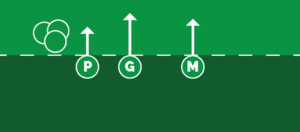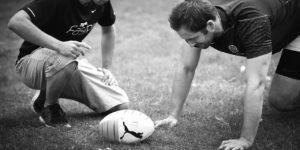Competitive rugby is tough; not only does playing at your best take a lot out of your body, the accumulation of knocks and minor injuries means you need to include plenty of rest and recovery in your weekly schedule. This leaves precious little time or energy for strength training, especially if you play most weekends, and also have to fit in team practices too.
But, and here’s the quandary that most ruggers face, you still need to maintain or even try and increase strength from one game to the next. After all, the last thing you want to do is lose your hard-won strength as the season progresses.
Research (1) suggests that just one or two workouts per week can maintain strength and power during the in-season, and if you build your workouts around compound exercises, you can stay strong with just three exercises per workout.
Simply ramp up to a top set of 3-5 reps, do 1-2 back-off sets with a slightly lighter weight, and then move on to your next exercise. For example:
Workout 1
- Squats
- Bench press
- Chins
Workout 2
- Deadlifts
- Military press
- Single-arm dumbbell rows
However, even such abbreviated strength training programs can take a big chunk of your time. After all, you need to get to the gym, warm up, train, cool down, shower, and get home again. That 40-minute workout could end up taking up two hours out of your already busy day.
If hitting the gym is impractical, it’s worth remembering that, ultimately, your body does not differentiate between sources of muscular work. It doesn’t know or care if you are lifting kettlebells, barbells, dumbbells, or a Shake Weight! All it knows is work and overload.
Bodyweight training for strength
One very effective and convenient way to maintain strength during the in-season is to perform bodyweight workouts. Conveniently, you can do bodyweight workouts anywhere, anytime, and without having to travel to the gym. In addition, bodyweight exercises are often easier on your beaten-up joints than many barbell and dumbbell exercises, making them ideal for use between games.
Most ruggers are familiar with bodyweight exercises, but may have written them off as a conditioning tool. However, bodyweight training can also be used to develop serious strength. Check out our recent article on gymnastic strength training to see just how effective bodyweight strength training can be.
However, it’s not enough just to knock out a few push-ups and bodyweight squats and expect to maintain your 200-lb. bench press or 300-lb. back squat. That’s not going to happen. While the movements are similar, the loads are too different. But, there are ways you can turn most bodyweight exercises into true strength exercises.
How to make bodyweight exercises more strength specific
Instead of banging out your usual high-rep sets of pushups and lunges, use these tricks to make common bodyweight exercises harder so they will help you to maintain strength during the in-season.
1. Use a slower tempo
The more slowly you perform an exercise, the harder it becomes. Slow repetition speeds increase time under tension, partially occlude blood flow, and eliminate momentum. Most exercisers use between a 1:1 and 2:2 tempo, meaning they take 1-2 seconds for the concentric (lifting) and the same for the eccentric (lowering) phase of each repetition.
Make your chosen bodyweight exercise more demanding by using a 5:5 or even 10:10 tempo. It’s good to know that not only is slower tempo training a good way to maintain strength, slow reps are easier on your joints. Good news if you are feeling banged up.
2. Incorporate mid-rep iso-holds
Mid-rep iso-holds break your usual rhythm, making whatever exercise you are performing much harder. When you transition from the eccentric phase of a repetition to the concentric phase, energy that is stored in your tendons and fascia provide your muscles with a little boost. However, when you pause for a few seconds mid-rep, that energy dissipates, making each repetition harder.
Simple pause for 3-5 seconds midway through each rep of your bodyweight workout e.g. at the bottom of bodyweight squats and lunges, and at the bottom of push-ups. Descend into the paused position relatively slowly, hold, and then explode out to maximize motor unit recruitment.
3. Use one limb at a time
If regular push-ups and squats present you with little in the way of challenges, try using just one limb at a time. However, don’t be surprised if you can’t do a single rep! Single limb exercises are much more than twice as hard as their two-limbed counterparts. This is because of loss of balance, stability, coordination, and altered movement mechanics. However, for building serious strength, single limb exercises are hard to beat.
Check out this video to learn how to do single-leg squats, aka pistols:
And this video for a one-arm push-up tutorial:
4. Use the dynamic effort method
The dynamic effort method involves performing your reps much faster than normal. The faster you try and lift your bodyweight, the more muscle fibers and motor units you will recruit at the same time.
It’s essentially the difference between slow squats and squat jumps. Instead of overcoming a heavy load slowly, you overcome a light load very quickly. The end result is the same – a lot of muscle tension.
The easiest way to use the dynamic effort method with bodyweight exercises is to see how many reps of a chosen move you can perform in 15 seconds. Crank out the reps as fast as you can, rest until the top of the next minute (45 seconds) and go again. Continue for 6-10 sets/minutes.
5. Strap on a weight vest
Make any bodyweight exercise harder by strapping on a weight vest. If you don’t have a weight vest, a small backpack will suffice. Start out with around 10-15 percent of your bodyweight and increase from there. Weighted vest push-ups are almost as good as bench presses for developing strength, and weighted vest squat jumps will kick your butt in no-time flat.
6. Train to failure
Recent studies (3) have revealed that training to failure, even using light weights and high reps, can increase maximal strength. These increases are not as great as for heavy weights and low reps, but, during the in-season, any increase is very welcome. This is good news for ruggers limited to bodyweight training; just make sure you take all your training sets to failure, irrespective of how many reps it takes. In addition, you’ll also increase local muscular endurance too.
7. Use occlusion bands
Occlusion training is also known as blood flow restriction training. By reducing blood and oxygen flow to your working muscles, muscle fibers fatigue much faster than normal, and using much less resistance. This means that even the easiest bodyweight exercise can become a serious strength training move. This might sound like bro science, but studies (2) have revealed that occlusion training really does work.
To use this training method, take a 4” wide elasticated band and wrap it snugly around your upper arm for upper body exercises, or the top of your leg for lower body exercises. On a scale of 1-10, wrap the band to a tightness of around 7-8.
Perform as many reps as you can of your chosen exercise, rest 30-60 seconds, and then go again. After a couple of sets, you will start to experience significant fatigue, plus a skin-splitting pump!
You can buy specially-made occlusion bands, just use your old knee wraps, or even a Theraband-type resistance band. Wider bands provide greater occlusion with less pressure and are generally more comfortable.
SUMMING UP
It’s good to know that you don’t need to hit the gym to maintain your strength in the off-season. Bodyweight training will help preserve your hard-earned strength – especially if you utilize these intensifying methods. Make sure you also emphasize rest and nutrition so that you recover fully between games and training. Consider using our Ruck Recovery (pro) stack for best results.
REFERENCES
(1) Effects of in-season strength maintenance training frequency in professional soccer players
(2) Low Intensity Resistance Exercise Training with Blood Flow Restriction: Insight into Cardiovascular Function, and Skeletal Muscle Hypertrophy in Humans
(3) Resistance exercise load does not determine training-mediated hypertrophic gains in young men
(4) Photo Credit: schoolofcalisthenics.com


